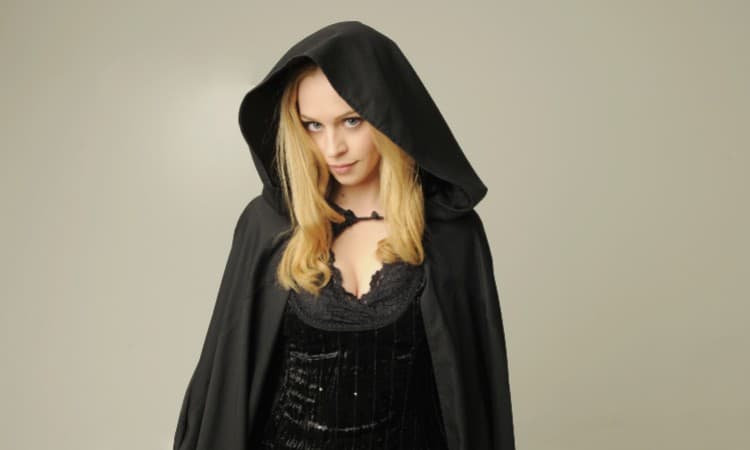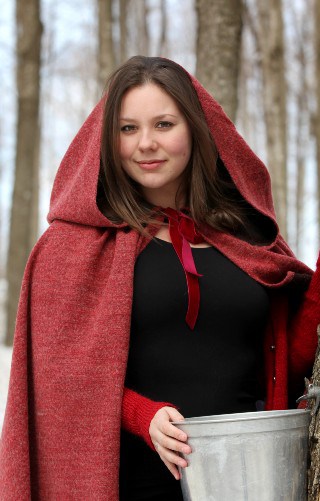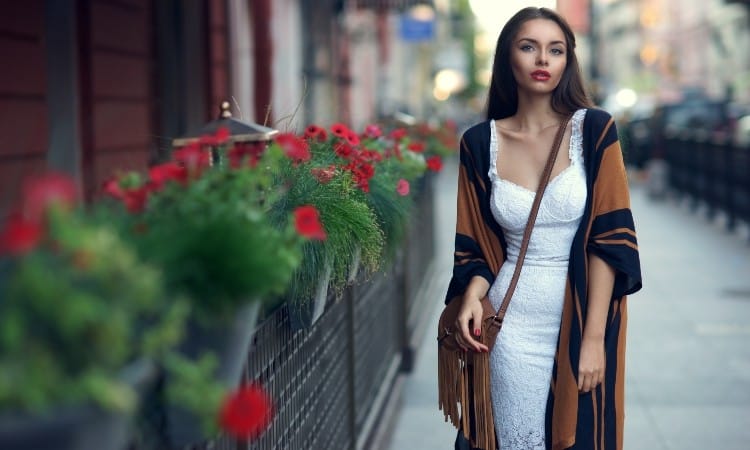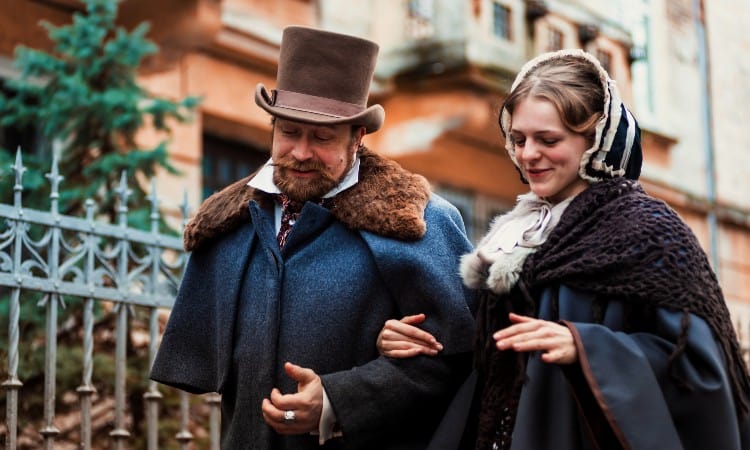The words cloak and cape conjure images of superheroes and hobbits. Both garments have swish appeal and add a touch of stylish mystery to your wardrobe. But which one is better? When it comes to cloak vs cape, what is the difference?
Cloaks and capes are both sleeveless outer garments made with one piece of fabric. The main difference between cloak and cape is the size. A cloak falls below the knee or to the ground and protects the wearer from the weather. Capes end at the waist or mid-thigh. Unlike cloaks, a cape is often used for fashion purposes.
Now you know a cloak and a cape are two different garments, which one will work better for you? Read on to discover more about the differences between a cloak vs cape.

Cloak vs Cape: Key Points
There isn’t much to choose from when it comes to differences between the cloak vs cape. Both garments are designed to keep the top half of the wearer dry and warm.
Each item of clothing has a particular function it’s better suited to. Cloaks cover your body around from the neck down to the lower leg. In some cases, a cloak will touch the floor. A traditional piece of outerwear cloaks keep your whole body warm.
Capes are a lot shorter. They go down as far as the thigh area and only cover the back of your body. Designed to be fashionable rather than practical, a cape is a great way to keep your shoulders warm on chilly evenings. Coupled with an off-the-shoulder ball gown, they create an image of romance and style.
Let’s take a look at some of the other key points that help identify your garment like a cloak or a cape. The following table gives a brief overview of the properties. We’ll go into more detail later in the article.
| Characteristics | Cloak | Cape |
|---|---|---|
| Area of Body | Chest, arms, and back | Back and arms |
| Fastenings | Fastened at the neck with a tie or clasp. Sometimes has buttons or clasps down the front | Fastened at the neck with a tie holding it on the shoulders |
| Function | Protection from inclement weather | Fashion accessory |
| Hood | Fully functional hood able to protect the wearer from the elements | Depends on the cape although the hood is usually just decorative rather than practical |
| Length of Garment | Calf-length or below the knee. Some cloaks touch the floor | Hip-length or mid-thigh. |
| Material | Traditional warm fabrics like wool. Can be made from velvet to indicate wealth and status | Fur or fine fabrics like silk Can also be made from wool and velvet |
| Sleeves | Sleeveless but sometimes has slits at the front to slide the arms through | Sleeveless |
| Worn by | History bounders, cosplayers, fantasy fiction characters like Hobbits and Harry Potter | Some military dress uniforms, Ladies cover-ups for eveningwear, Superheroes like Batman, Superman, and Wonder Woman |
What Is a Cloak?
 A cloak is a whole-body covering designed to be worn in cold or wet weather. They can be pulled tight across the front for added warmth. It’s a bit like wearing a woolen blanket. Many cloaks are made from heavy fabrics like wool due to the insulating properties it possesses.
A cloak is a whole-body covering designed to be worn in cold or wet weather. They can be pulled tight across the front for added warmth. It’s a bit like wearing a woolen blanket. Many cloaks are made from heavy fabrics like wool due to the insulating properties it possesses.
During medieval times, the cloak would have been the go-to garment for people from all walks of life. Although it would have had the same basic design regardless of social class, the type of fabric would have set different types of people apart.
The material used would differ depending on if it was for a wealthy person or someone of lower standing. Royalty, for instance, would have used fine fabrics or velvet. Their cloaks would have been ornately decorated with embroidery and fancy embellishments.
Humble folk would have stuck to wools. Their cloaks would have been plainer and more practical. Less likely to travel in carriages or by horse, the fabric in their cloak would have protected them from the elements and the dirt of the road.
To be a cloak, it has to encompass your body from neck to toe. Some cloaks end at the calf level, while others touch the ground. Most have a fully functional hood to keep out the rain and are sleeveless. Although for front-fastening cloaks, there are sometimes small slits for the hands to come out.
Cloaks have fallen to the wayside of fashion over time. These days they are only worn by those into history bounding, historical re-enactment, and cosplay. The cosplay group gets their love of the cloak from TV, film, and fantasy fiction. All of which helps keep the cloak alive.
One such work of fiction that brought the cloak back to people’s awareness was the Harry Potter series. They used cloaks as part of the Hogwarts school uniform. Although technically, they were robes as they had sleeves. Still, whether it’s a robe or a cloak, it’s the ideal garment to add magic to a wizard series.
Then there’s the Lord of The Rings series. Hobbits from the shire wore cloaks on their long journey to Mordor. A dark and gloomy trail full of foreboding. A cloak is a perfect garment to snuggle into and keep the evil Sauron at bay.
All of this embraces the cloak’s identity as a utility garment designed to keep the wearer cozy and dry. In contrast to the cape, a cloak is both practical and functional. It gives the wearer the appearance of calmness and being in control. Nothing is impossible when you wear a cloak.
What Is a Cape?

A cape is a piece of fashionable outerwear similar in style to a cloak. Capes fasten at the neck, rest on the shoulders, and cascade down your back. Normally reaching only as far as your hips or mid-thigh area, a cape is a lighter, shorter version of a cloak.
Although capes usually only cover the back of your body, they sometimes have enough fabric to reach the front. A cape won’t meet in the middle, though, so it will always be open. Apart from the string used as a tie at the neck, there are no fastenings on a cape.
The size and shape of a cape make it an ideal cover-up for your shoulders and upper arms. The cape adds interest and style to an off-the-shoulder ensemble, working in the same way as a shrug or bolero jacket. Keeping you warm and comfortable in the process.
Capes have been around since medieval days and have always been a symbol of wealth and importance. Ones made out of fur, for instance, would be added to expensive garments to add extra panache. Because of this, capes have always been associated with fashion and status rather than practicality.
Even today, capes are synonymous with frivolity and fun. Whenever you think of a suitable costume for a superhero, the chances are, there’s going to be a cape. They have the swoosh factor and look great in action shots.
Both Superman and Batman are well-known cape wearers. Wonder Woman, whether she’s from the original TV series of the 1970s, or the films of recent years, has also worn a cape of some description. Helping to cement the cape’s reputation as an accessory or embellishment to an outfit.
What Is the Difference Between Cloak and Cape?
Cloaks and capes are so similar the two terms have become interchangeable over the years. Although this may be the case now, back in history, the differences between a cloak vs cape would have been more obvious.
Each one has pros and cons that make them better suited for some situations. Let’s take a look at some of the characteristics associated with both to see which one fairs better.
Style
 The style of both cloaks and capes is very similar. They are both sleeveless outer garments worn across the shoulders. This is where the similarities end, though. Each garment is designed for a particular function and some individual style elements help them achieve their purpose.
The style of both cloaks and capes is very similar. They are both sleeveless outer garments worn across the shoulders. This is where the similarities end, though. Each garment is designed for a particular function and some individual style elements help them achieve their purpose.
Capes are fashion accessories used to uplift a garment and give it a hint of romance and glamor. Sitting on the shoulders, they are tied at the neck and cascade down your back. Creating a soft silhouette that adds mystery and intrigue to eveningwear. Or pomp and ceremony to a military dress uniform.
Cloaks, on the other hand, are steeped in practical attributes. From the fabric through to the no-nonsense body-covering, cloaks encompass what it means to be calm, confident, and in control. They simply ooze a steadfast common sense and eagerness to complete a task with both style and aplomb.
Length
 While a cloak can completely cover your body from your neck to your feet, a cape will end close to your hips. This seemingly small difference can make one garment better than the other in some situations.
While a cloak can completely cover your body from your neck to your feet, a cape will end close to your hips. This seemingly small difference can make one garment better than the other in some situations.
A cloak’s length can sometimes get in the way. Being a long garment, it can be easy to trip over. One of the main reasons superheroes choose a cape over a cloak is because it’s shorter. Less likely to tie you in knots, the compact size of the cape is ideal for a quick getaway.
Even if you’re not a superhero, a shorter cape fits in with modern lifestyles easier. As it ends at your hips, it will be out of the way when you’re driving your car. You won’t sit on it either, causing it to pull on the neck fasteners and making you uncomfortable.
Cloaks may keep you cozy from head to foot, but that much length can be cumbersome. From a modern perspective, that can be more trouble than it’s worth. The cape wins this point.
Hood
 Sometimes having a hood is a great advantage. They do more than keep the rain off your head; they can also keep your ears warm and out of the wind. A cloak has an in-built hood that is as robust and weatherproof as the rest of the garment.
Sometimes having a hood is a great advantage. They do more than keep the rain off your head; they can also keep your ears warm and out of the wind. A cloak has an in-built hood that is as robust and weatherproof as the rest of the garment.
There’s also the ability to stay hidden, should your swashbuckling history bounding adventure call for it. With its integral hood covering your head, you can hide away in the shadows. Your cloak can help you elude capture, allowing you to cosplay another day.
Although capes can have hoods, they tend to be for show and lack the body and coverage offered by a cloak. Capes tend to be flamboyant and are better suited to making you look good rather than practical.
If a hood is an important part of your ensemble, you need to choose a cloak as part of your outfit. This is one area the cloak wins, hands down.
Sleeves
No products found.As neither capes nor cloaks have sleeves, this one is a little harder to choose between. A cape only covers your back, shoulders, and upper arms. Leaving your hands free and giving you full movement.Cloaks cover everything from the neck down, including your arms. This can be great if you want to tuck your arms in and be warm. Simply use your hands to pull the cloak tighter around you and you’ll be super snug.
Even though cloaks are sleeveless, they still have a trick up their… sleeve. There are slits at each side for cloaks with front fastenings to enable you to poke your hands through. This is an awesome feature as it gives you the best of both worlds. The functionality of sleeves in a sleeveless garment is priceless. Cloaks win this one for pure adaptability.
Functional Purpose / Usage
Similar they may be, but cloaks and capes are very different in functionality and usage. Depending on your requirements you’ll find one is better than the other for some things.
Capes aren’t designed for functionality. They add a touch of zing to an outfit. With their hip-level length and floaty swish as you move, their purpose is to add glamor, mystery, and charisma. A cape will accessorize your garment and make you look great. Due to its style and design, it can’t keep your body warm or the rain out.
Cloaks, in comparison, can seem a little boring. What they lack in glamor, they more than make up for in functionality. A cloak has practicality in bucket loads. Not only can a cloak keep you dry, but it will also keep you warm. All while adding a hint of purpose to your outfit and competence to your persona.
Material
Being utilitarian garments, cloaks tend to be made from robust, heavy fabrics. Although you can get cloaks made from lighter fabrics, it’s more usual to find them made for combating the weather. Materials like wool or velvet are ideal for cloaks.
On the other hand, capes can be made from utility, fashion, and even fine fabrics. Silk or silk substitutes are a firm favorite for capes. So is fur. Any material that adds an opulent charm can be used in a cape.
This one is a win for capes. As they are a fashion and style accessory, there is no limit on the fabric you can use. Let your imagination run wild and choose a material to match your individuality.
Fastening
Fastenings used on cloaks and capes are dependent on the style of your garment. It’s only really the cloak that can have a range of options.
Capes are tied around the neck and sit on the shoulders. They don’t stretch around to the chest area, so they don’t need any further fastening device on the front. This can make them a little too light and breezy for chilly days or wetter weather.
Cloaks can be fastened at the neck with ties in the same way as capes. This works well for the more open style of the cloak. For those that wrap around to the front of your body, extra fastenings can be added to the front section. These can include clasps, buckles, buttons, or toggles.
For versatility, cloaks are the winner. Having more fastener options allows the cloak to be used in all weather conditions. From the strong winds and rain of fall to the milder days of spring. The fastenings make cloaks suitable for more than one season.
Price
You’ll probably find capes are less expensive than cloaks. This is down to more than just the amount of fabric there is in a cloak. Capes may be shorter, but they are also made from a range of materials, which can help reduce the cost.
Due to being an inclement weather garment, Cloaks tend to rely on fabrics like velvet or wool. The heavier the fabric, the more pricey it is to buy. There are cheaper alternatives available, like polyester fleece. But, as many cloak wearers today are interested in historical accuracy, their cloaks are more likely to use the expensive natural fiber options.
Capes can be made from any material and don’t need nearly as much. The cost to make a cape is relatively cheap compared to cloaks. Even fur options can be made cheaply with imitation fur. You get the same effect but at a budget-friendly price. As capes are seen as fashion accessories, the desire to be historically accurate is not as great as it is with cloaks.
Do People Still Wear Capes and Cloaks Anywhere?

Yes. People still wear capes and cloaks. Only not for everyday wear. Although both garments have appeal, neither is a regular wardrobe staple.
You are more likely to see someone wearing a cloak as part of historical re-enactments. Cosplayers wear cloaks when dressing up as their favorite fantasy character, like a Harry Potter character or a Hobbit from Lord of the Rings.
Movies and TV are the main places where you will see cloaks in use today. Think Game of Thrones or a period drama like Wuthering Heights.
Capes have come in and out of fashion with the passing decades. Their last foray into the world of style was in the 20th Century. The 1920s and 1930s saw capes become popular due to being worn by popular movie stars. They would be used as shrugs or boleros to cover a lady’s shoulders while wearing ball gowns or evening wear. It is still a usual site to see formal clothing topped with a cape.
Is It Socially Acceptable to Wear a Cape?
If going against the current trend or standing out from a crowd bothers you, then no, it isn’t socially acceptable to wear a cape.
It’s a sad fact of life that capes are no longer as popular as they used to be. Because of this, wearing a cape in everyday wear will get you looked at. As it’s no longer the norm, you may be singled out as being different or going against modern fashion. Worst case scenario, you could get jeered at.
However, why not buck the trend? Capes are out of fashion right now because no one is wearing them. Not because they don’t want to, but rather, they haven’t thought about capes. Start wearing your cape out and about and people might think, “Wow! That looks great!” You could be your own trendsetter and start a new craze!
Cape vs Cloak vs Mantle
Now that we’ve looked at capes and cloaks and explored their differences and similarities, there is another cloak-like term we need to investigate. Cloaks or capes can also be called mantles. But why? What is the difference between cape vs cloak vs mantle?
A mantle is an open cape or cloak used mainly for authoritative positions. Also known as robes, these mantles are worn by people in positions of power or status holders. Normally the mantle is part of their ceremonial dress. Think orthodox bishops or the fancy robes used in royal ceremonial events.
The term is so synonymous with professions or positions of importance it has coined a phrase. To ‘don the mantle’ means to take on the responsibilities and duties of a role.
While each term, cape, cloak, and mantle, refer to similar garments, the one you choose will be determined by the image you want to portray. Footloose, fashionable, and fancy-free would suit a cape. Pomp and ceremony scream mantle. For weather protection and the hint of adventure, go for a cloak.
Conclusion
Now you know the differences between a cloak vs cape, you should find choosing between the two a lot easier. You might even find the mantle is more suitable for your project!
Let me know in the comments if you liked the article. Are you considering wearing a cape, cloak, or mantle? Which one do you think you’ll go for?